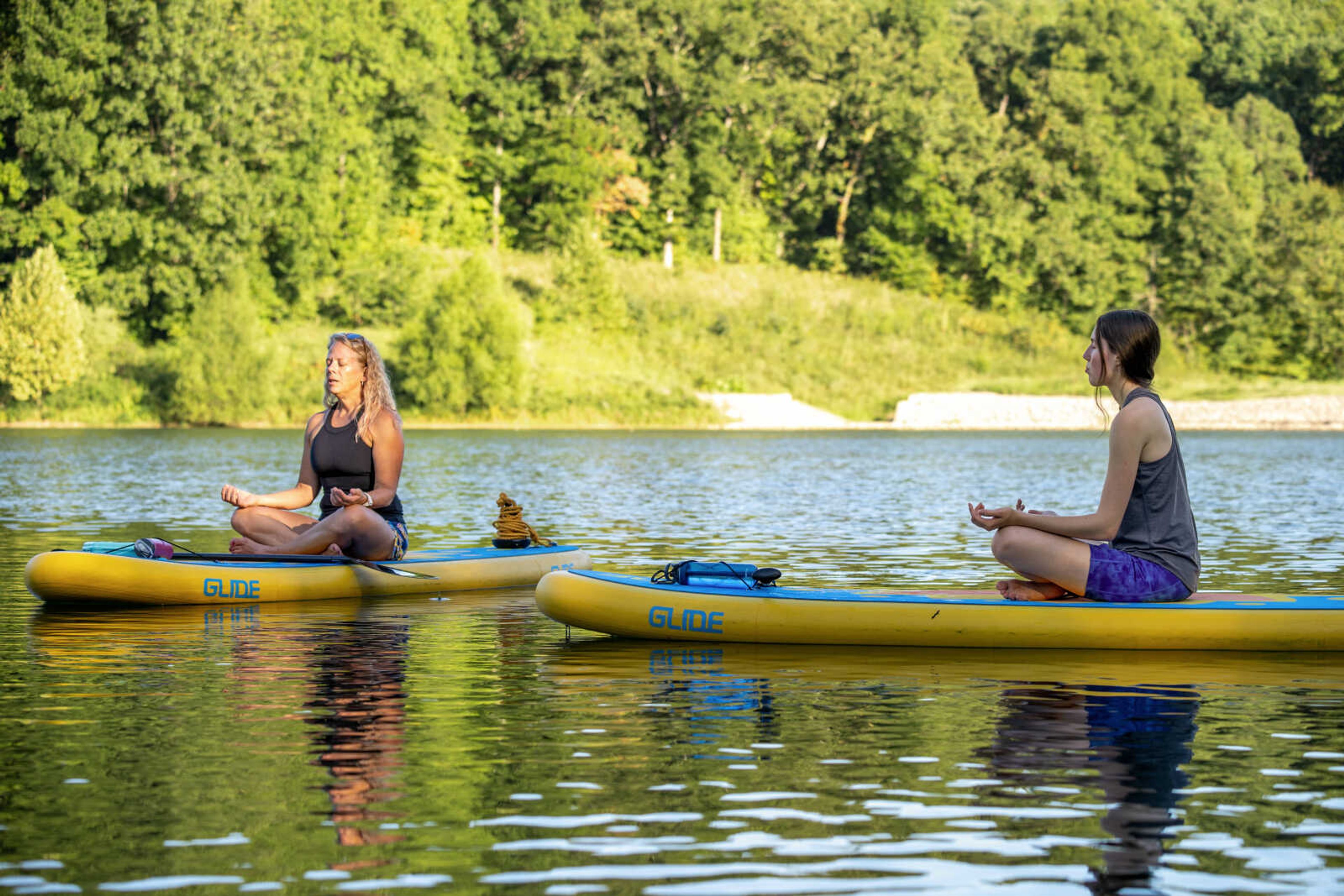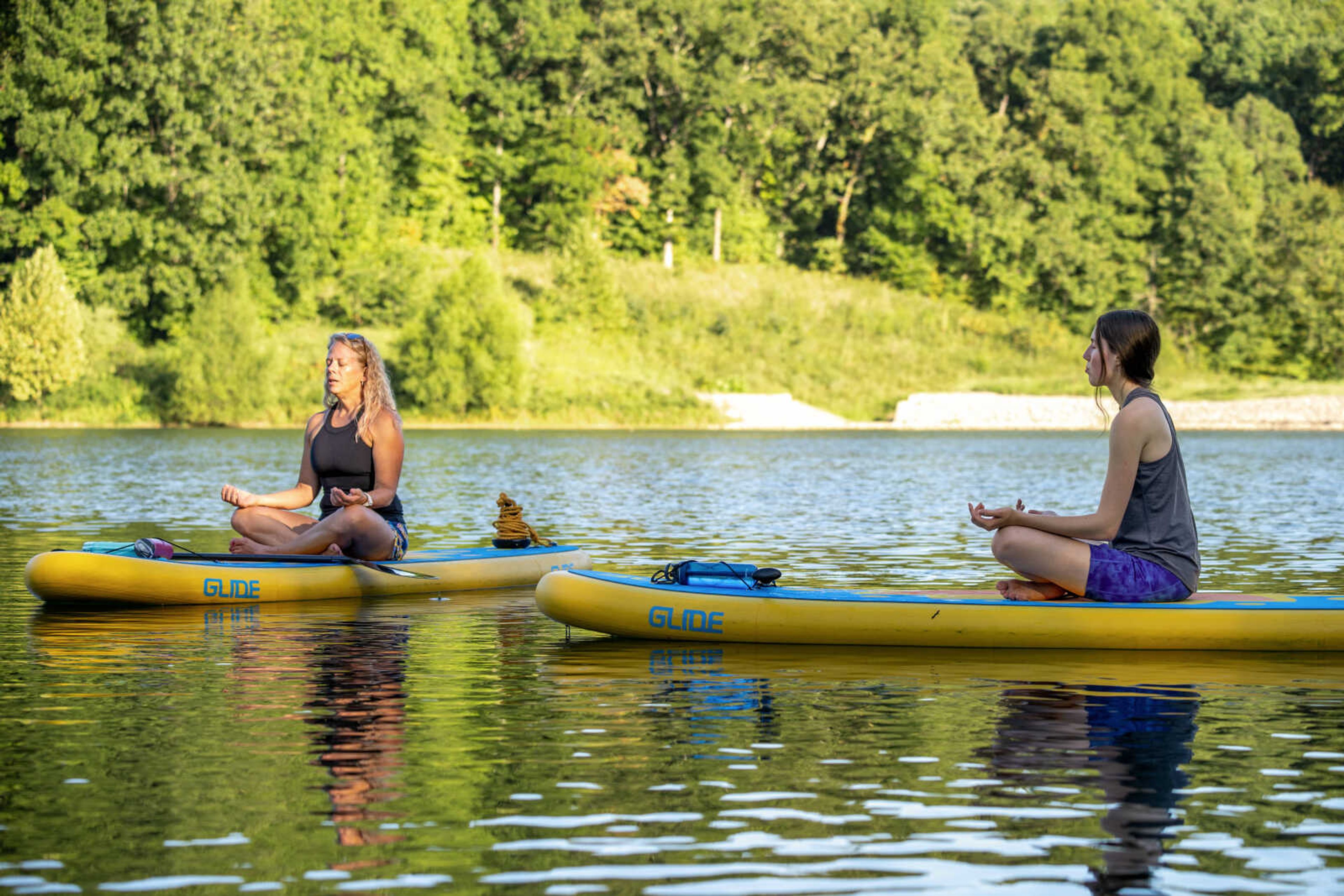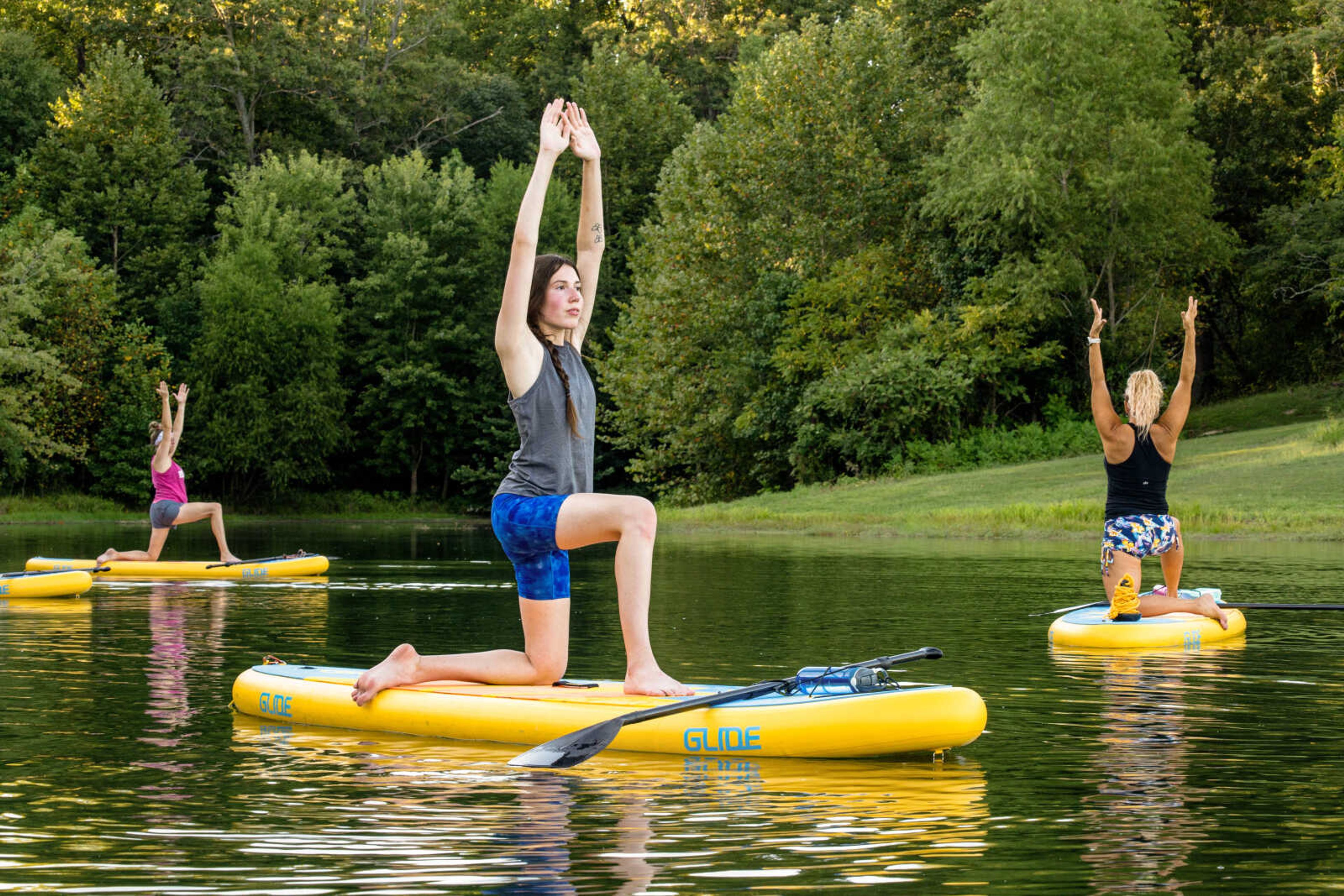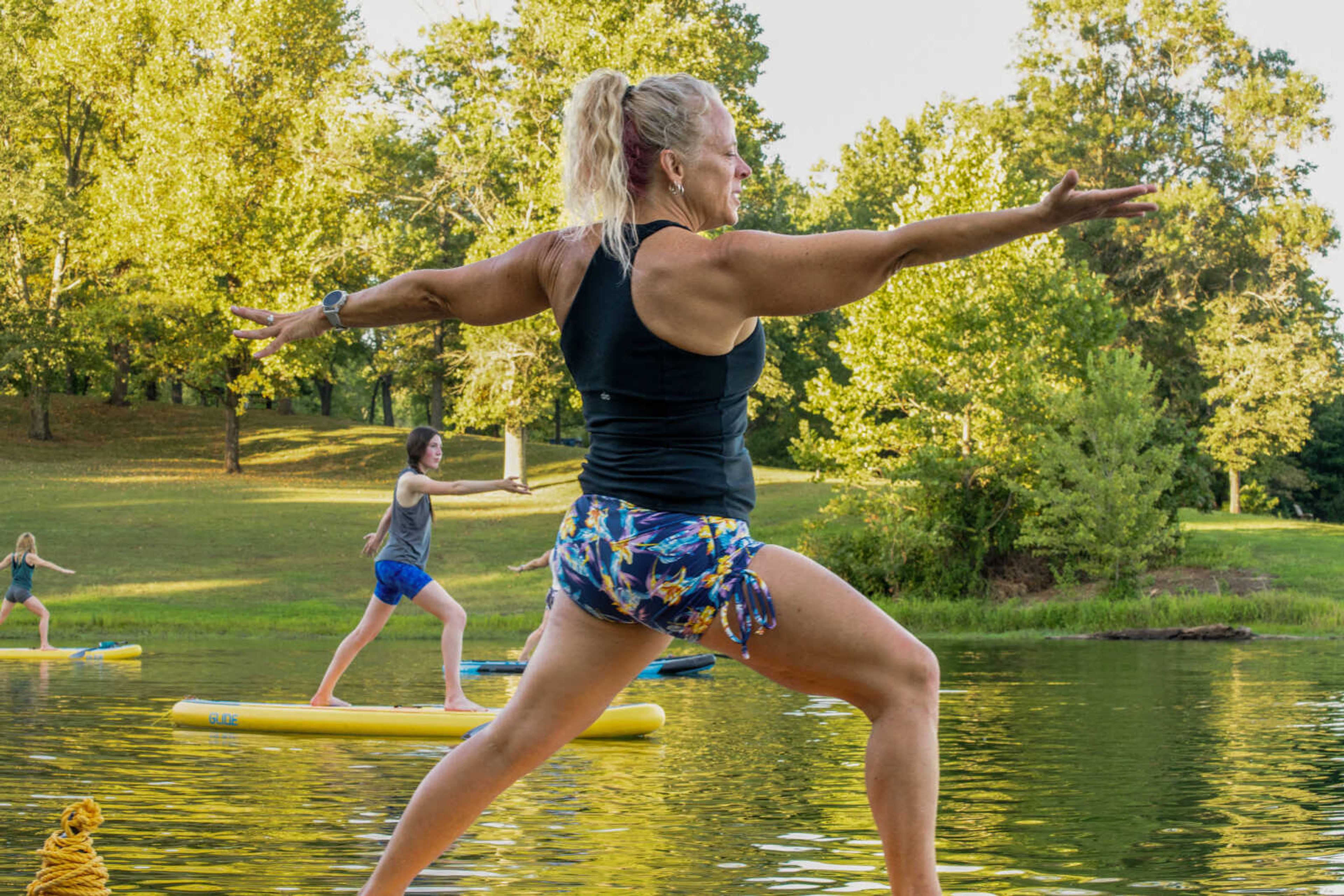The Balance of Beginning: Trying paddleboard yoga for the first time
“It’s not a big deal if you fall in.” It’s one of the first things stand up paddleboard (SUP) yoga instructor Missy Nieveen Phegley tells me when I arrive for her class one summer evening. While we talk, myself and a group of six women walk toward Trail of Tears State Park’s Lake Boutin with large, yellow paddleboards tucked under our arms...
“It’s not a big deal if you fall in.”
It’s one of the first things stand up paddleboard (SUP) yoga instructor Missy Nieveen Phegley tells me when I arrive for her class one summer evening. While we talk, myself and a group of six women walk toward Trail of Tears State Park’s Lake Boutin with large, yellow paddleboards tucked under our arms.
The one time I’ve tried paddleboarding flashes in my mind: 14 years old, alone, wavy lake. I remember falling off my board, then falling off again and again and again for hours. That day, I mostly swam around with the large mass hugged between my arms, using it as an expensive floatie until my rental time expired.
Now, I’m about to stand on a paddleboard again after eight years and do yoga poses — on the paddleboard. I lower my expectations and prepare to fall into the water many, many times. I am not afraid to tell everyone in the SUP yoga class I’m a beginner; I am not afraid to ask an annoying amount of questions about which way the paddle faces or how to stand up on the board.
Another student says she’s glad I’m trying the sport, and that SUP yoga “really evokes the beginner’s mindset.”




SUP yoga is the practice of yoga on a paddleboard in the middle of a body of water, usually a calm body of water. According to Reuters, modern SUP yoga originated in Hawaii during the 1950s and ‘60s and quickly became a favorite activity for yoga and watersport lovers alike. Although I don’t practice yoga regularly, I’ve taken enough classes to be comfortable in a studio; practicing yoga on water, however, is a completely different story.
Hesitantly, I carry the board down the loading dock and place it into the water with the other students’ boards. Missy guides me onto the unstable plank and hands me a rope-wrapped anchor to secure on the back. I scoot back carefully on my knees and clip it onto a loop.
Two of the women in the class are already halfway into the lake, gracefully scooping water away from their boards with long paddles. They make standing on water look normal, easy, involuntary — an act as simple as breathing or blinking.
It’s time for me to join them. With a deep breath, I place my feet in the middle of the board, one on either side of the center handle. Missy reminds me to keep my weight centered over this spot, both while paddling and attempting yoga poses later.
There is nothing else to wait for; I stand. I expect the board to wobble beneath my feet, knock me into the cold lake with a smack, but it doesn’t. The board remains stable, even when I begin scooping water with my paddle. With every scoop, courage builds in my mind and limbs. I paddle happily, with more force, inching closer to the center of Lake Boutin.
“You’ve got the paddle backwards!” Missy yells from behind me. “Keep the flower design forward!”


She must be talking to someone else, I think, but then I look down to see the flowers poking out at me. I turn the paddle around and continue rowing into the lake, following those before me. We meet at a cove on the opposite side of the lake, shaded by trees, overlooking the rest of the lake and surrounding woods.
Other students are already sitting down on their boards and dropping their anchors, but sitting on the board seems impossible to me. I simply can’t imagine making the transition from standing to sitting, so I bend slowly, slowly, slowly until my body has no choice but to sit.
A similar irrational fear grips me as I drop the anchor. I expect the weight of the dense metal to tilt my board into the water, but it doesn’t. The anchor disappears into the blue, and Missy instructs me to pull up the rope’s slack and tie it in a knot to prevent the board from moving. I pull up the slack and tie it in the best knot I know how to tie, which isn’t really a knot at all.
Then, the SUP yoga class officially begins.


We start sitting cross-legged on our boards with eyes closed. Missy tells us to inhale and exhale, inhale and exhale. I feel the oxygen fill and deflate my lungs, and for a second, I forget I’m on water.
“Focus on the sounds around you,” she says. “Hear the birds. The bugs. Feel the sun on your skin. Feel the slight breeze.”
Missy’s voice is moving, and when we open our eyes again, I notice her board is not anchored down. Then, I notice I am moving, too, going in every direction the water turns. The knot on the back of my board has come undone. I think about retying it, but decide to let go of my control, learn to balance as the waves come. If I came this far, I’m sure I can handle a little movement.
Missy explains how SUP yoga will improve our yoga on land, because it forces us to focus on where we put our weight during yoga poses. Balance depends on dispersing weight evenly between each foot, centering ourselves over the board. On land, it’s easy to get lazy, to put all our weight in one place without realizing it. But here, we must be conscious of our bodies, unless we want to go for a swim.
We move into a series of yoga poses, shifting from standing to sitting, and transitioning between downward dog and child’s pose. I am amazed at the stability of my two feet and how easily I forget I’m doing yoga on water.
Missy has us hook our feet around the board into an adjusted warrior pose, a pose typically done standing in a deep lunge with arms outstretched to the sky. We do this, and then, she challenges us to try it standing.


Since I haven’t fallen yet, I feel brave, so I place my feet on the centerline of the board. I feel it wobble as I shift my weight to the center, plunging deeper into a real lunge, a real warrior pose on water. She tells us to lift our hands and my board tilts to the side, and I think, “This is it. I’m falling.” But I’m not falling. My balance returns, the board stops rocking, and the world as I know it stabilizes.
After a series of simpler yoga poses, Missy sits criss-cross and uses her hands to lift her body off the board in a pose she calls “lotus.” We attempt to do the pose, but none of us can pry ourselves off of the board. Everyone laughs, and we move into the last period of the class, which focuses on recentering and relaxing.
Missy invites us to lay flat on our boards, close our eyes, allow our hands to sink into the water and breathe deeply. The water feels like silk between my fingers, as my ears focus on the orchestra of bugs and birds surrounding us. We rest there for what feels like eternity, doing nothing but laying on water, floating between each others’ boards. When Missy tells us to open our eyes, I am amazed by the brightness of the sky. I had forgotten how colorful the world is.
Missy tells us to untie our anchor knots — already done. She tells us to lift our anchors out of the water, but expect them to feel like 1,000 pounds because of the mud they’re stuck in, and she’s right. I have no idea how I’ll lift my anchor; I am already preparing to ask for help; I am already preparing to stay stuck in the lake.


I start pulling, and the yellow rope continues on forever; it is a never-ending worm of bright yellow. I think, “I must have lost the anchor to the earth,” until finally the muddy anchor pops out of the water. I secure it to the back of my board and paddle out of the cove with the other students, feeling content with another challenge overcome.
As I paddle, flower facing the correct direction, I overhear other students talking. One student jokes about her dogs hopping onto the paddleboard with her. One talks about electric pumps for blowing up paddleboards quicker. Another talks about her Current River SUP trip. They all agree the Current River is the best place for paddleboarding.
They talk with experience and passion; they are not beginners, but at one point, they were. I think back to a student’s earlier comment about how SUP yoga evokes a “beginner’s mindset.” I have to agree. The meaning of standing and sitting and doing yoga poses took on a whole new meaning during class, while doing those familiar actions on water. I could no longer say, “Yes, I can do this action;” I could no longer be certain of my abilities. It was a new feeling; terrifying, freeing.
I remember we start as beginners with everything in life: eating, talking, reading, driving, dancing. As an adult, sometimes I forget what that feels like, to step out into something completely unknown, to learn through action, one paddle at a time.
Missy tells me she loves to see beginning students’ abilities and confidence grow. A lot of the time, she says, a student will paddle to the yoga cove sitting down, unsure of themselves. But on the way back, they stand.


I pull my paddleboard out of the water and join the other students in the parking lot. We let the air out of our boards and sit on them until they deflate. I stand up, and the word has taken on a new meaning. I am ready for more beginnings. I am ready to stand.
Connect with the Southeast Missourian Newsroom:
For corrections to this story or other insights for the editor, click here. To submit a letter to the editor, click here. To learn about the Southeast Missourian’s AI Policy, click here.










